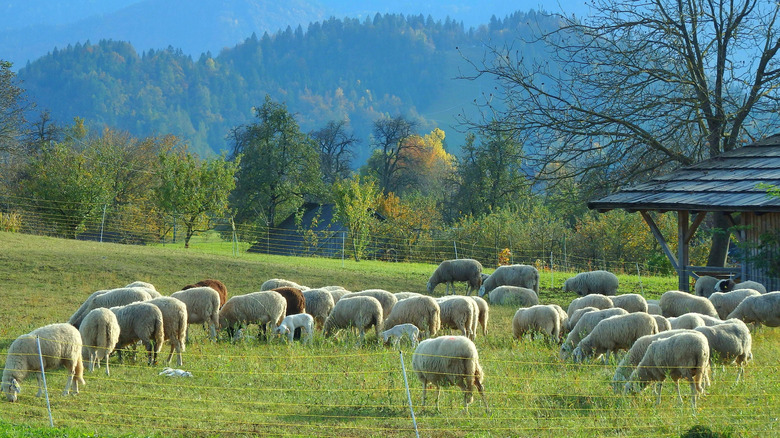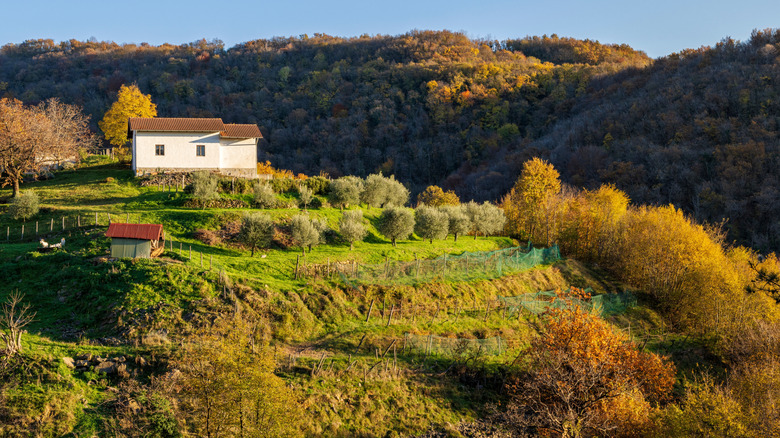Slovenia's Most Charming Farm Restaurants Offer A Rustic, Traditional Experience Amid Stunning Scenery
There's tasting the terroir of a new place, and then there's completely immersing yourself in it. Think juniper brandy fermented in the building in which you're dining, perhaps not far from where the prosciutto is curing, or honey ice cream made from the on-site hive. Dining at a charming farm restaurant in the Slovenian countryside offers a rustic, traditional experience amid stunning scenery.
Why Slovenia? Even travel expert Rick Steves has called the overlooked country one of Europe's most unexpected charmers. That's due in large part to its location bordering Italy, Austria, Hungary, and Croatia, with cultural influences from them all. The travel expert is a fan of the cuisine, specifically noting that the irresistible desserts like fluffy kremna rezina are "reason enough" to make a trip. Slovenia's gastronomy is best sampled in its place of origin, and there are plenty of tourist farms, or turisticna kmetija, at which to do so.
One of the best areas to sample the quiet life is the Karst Plateau, in Slovenia's southwestern region, kissing Italy. In the area, also simply known as Karst, agritourism is alive and well. There are many places that not only feed guests the best of the farm but also allow them to stay in comfortable lodging, too. And it's less than a 50-minute drive from the capital city of Ljubljana. But then again, nothing in Slovenia is terribly far from central Ljubljana since the entire country is roughly the size of Massachusetts.
What to expect of a farm dinner in Slovenia
First, there's the matter of deciding when to go to the farm. Late summer and early-to-mid fall is the harvest, but for meat lovers, it might be worth scheduling your trip to coincide with the tradition of Koline or Furež, the wintertime pig slaughter. Much like the Cajun custom of boucherie, Koline is a communal event where farmers share every part of the porker that's dispatched, from sausage made using the blood and fat to cracklings crafted from the animal's skin.
A meal at a tourist farm will likely begin with brandy made from fruits grown on the farm. Whether it's juniper berries, plums, or pears, it all packs a wallop. Think of it as an aperitif to prepare your body for the onslaught of mouth-watering vittles to follow. Appetizers might include pâtés made from the animals nearby, like pigs, lamb, or the local wild game.
For example, at tourist farm and brewery Pivovarna Ambrožič in the Karst Plateau town of Vremski Britof, the four-course bill of fare may start with charcuterie, then move immediately to bolstering soups, pasta dishes, and polenta cakes with prosciutto, cheese, and grilled porcini mushrooms. Entrées are decidedly meaty, ranging from rabbit to venison, followed by desserts that mostly trade in seasonal fruit. And to finish? More brandy, of course, to aid in digestion.
How to find a tourist farm in Slovenia
Choosing a tourist farm depends on which part of Slovenia you want to taste. Are you a sucker for wine? Select the Karst's Brda region for its location between the Alps and the Mediterranean, where the sunny climate leads some to compare it to Tuscany. Thanks to its proximity to Friuli in Italy, spots like Breg Tourist Farm in Dobrovo boast cheesy, crispy frico; plus, stuffed gnocchi and chestnut minestrone among its farm-to-table enticements.
Perhaps you prefer thermal springs amid rolling hills? The northeastern Prlekija region is home to the Firbas Homestead. Here, guests can sleep in a chicly converted hayloft and sample foods grown on-site for breakfast, lunch, and dinner between educational tasks and tours. You can expect dinner to include fresh cheese, sourdough dumplings, and house wines before ending with a layer cake.
There's also the option to stay among the relatively undiscovered delights of Ljubljana and simply have dinner on a farm. This is achieved at Grofija Tourist Farm, about a 30-minute drive from the big city. There, guests who schedule ahead can stop in for preserved meats, house-baked breads, and liqueurs crafted on-site. Best of all, it's located on an Iron Age historic site. After all, you'll need something exciting to compel you to get up from the table and work off that unforgettable repast.


